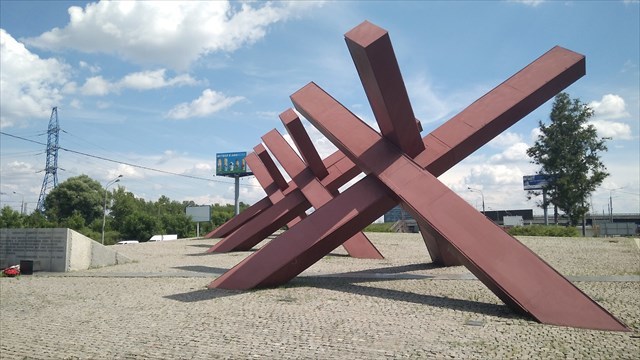Противотанковые ежи были одним из самых эффективных и простых оборонных средств во время Великой Отечественной войны. В военной Москве для их изготовления использовали стальные балки, предназначавшиеся для строительства Дворца Советов. Объемные шестиконечные конструкции и сегодня возвышаются на 23-м километре Ленинградского шоссе в Химках. Именно в этом районе проходил боевой рубеж осенью 1941 года, когда было предпринято крупное наступление на Москву.
Монумент возведен архитекторами А. А. Агафоновым, И. П. Ермишиным, А. Михе и инженером К. И. Михайловым из камня, железа и железобетона. Над его созданием трудилась также молодежь Москвы и области. Открытие состоялось в декабре 1966 года и было приурочено к 25-летию разгрома немцев под Москвой.
Памятник славит всех советских граждан, сражавшихся в годы Великой Отечественной войны, и воплощает идею неприступности столицы. О начале контрнаступления в декабре 1941 г. свидетельствуют строчки из сводки Совинформбюро, высеченные на постаменте перед 10-метровой конструкцией «Ежей»: «В последний час… 6 декабря 1941 года войска нашего Западного фронта, измотав противника в предшествующих боях, перешли в контрнаступление против его фланговых группировок».
Детали комплекса — карта обороны Москвы, выполненная в технике мозаики, и гранитные плиты с изображением лиц защитников города: солдат, а также рабочих, трудившихся в тылу. Несмотря на численное превосходство противника, он был отброшен на значительное расстояние от столицы.
«И врагу никогда не добиться, чтоб склонилась твоя голова» — начертано вдоль ступеней, ведущих к памятнику.
То, что монумент расположен рядом с Ленинградским шоссе, долгие годы негативно влияло на его сохранность. В 2011 году была завершена реставрация памятника, включавшая расчистку деталей от копоти и грязи. С «Ежей» сняли старую краску, загрунтовали их и окрасили заново.

Antitank hedgehogs were one of the most effective and simple defense means during the Great Patriotic War. In military Moscow for their manufacture, steel beams were used, intended for the construction of the Palace of Soviets. The voluminous six-pointed structures are still on the 23rd kilometer of Leningradskoye Shosse in Khimki. It was in this area that a militant boundary took place in the autumn of 1941, when a major offensive was launched on Moscow.
The monument was erected by the architects AA Agafonov, I. P. Yermishin, A. Mikha and engineer K. I. Mikhailov from stone, iron and reinforced concrete. The youth of Moscow and the region also worked on its creation. The opening took place in December 1966 and was timed to coincide with the 25th anniversary of the defeat of the Germans near Moscow.
The monument glorifies all Soviet citizens who fought during the Great Patriotic War, and embodies the idea of the inaccessibility of the capital. On the beginning of the counter-offensive in December 1941 "Answer to the question": "At the last hour ... December 6, 1941, the troops of our Western Front, having exhausted the enemy in the previous battles, went into a counteroffensive against his flank groups."
The complex's details are a map of Moscow's defense, made in mosaic technique, and granite slabs depicting the faces of city defenders: soldiers, as well as workers working in the rear. Despite the fact that he was thrown a considerable distance from the capital.
"And the enemy will never get your head bent" - is inscribed along the steps leading to the monument.
The fact that the monument is located next to the Leningrad highway, for many years negatively affected its safety. In 2011, the restoration of the monument was completed, including the clearing of details from soot and dirt. With the "Hedgehog" they took off the old paint, primed them and painted again.